“The Foxglove, with its stately bells of purple, shall adorn thy dells.” ~ David Macbeth Moir
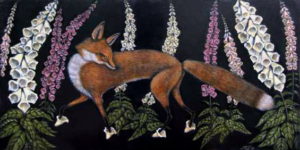
Foxgloves, by Kelly Louise Judd
Good morning, everyone! Today finds me thinking of Foxgloves (Digitalis). They are, in my opinion, one of the many lovely and enchanting plants of the garden world. To me, they are gorgeous, with their little bells and speckled throats. But, where and when did they get their name?
If you look closely at the painting by Kelly Louise Judd, you will see the fox has little bells on his feet. In Scandinavia, it is believed that the foxes wore these little bells on their feet so as not to make any noise, better equipping them to raid the henhouse. Hence the name ~ Foxglove. Additionally, in Scandinavia, it is believed that fairies taught foxes to ring the little bells to warn other foxes of hunters.

“Be inspired by spires in the lovely month of June.” ~ Michelle Cook
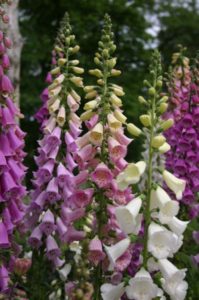
Flower folklore also holds the thought the name Foxglove is said to come from the original term which was ‘Folksglove’ with folks originally meaning fairies. They are often referred to as fairy petticoats or fairy gloves. Additionally, in the book English Etymologies, published in 1847, the following is stated, “In Welsh, this flower is called by the beautiful name of maneg ellyllon, or the fairies’ glove. Now, as every one knows, these little elves were called in English ‘the good folks.’ No doubt, then, these flowers were called ‘the good folks’ gloves, a name since shortened into foxgloves. The plant is called in French, gantelée (little glove); in Latin, digitalis, and in German, fingerhut (thimble). It is worthy of remark, that the Greeks appear to have called it by a name which is different from the above, but not inappropriate, the trumpet flower.”
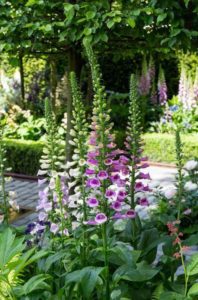
There are numerous stories about the Foxglove and many feature fairies wearing their bells as hats and gloves. It is said the fairies live inside the flowers and the reason their spires bend so gracefully is they are bowing to all beautiful beings who pass them. Folklore also says that Foxgloves keep evil at bay when grown in your garden, but are considered unlucky when brought into the house.

“With modest blush in bosky dells, hangs her dewy purple bells; So softly nodding in the breeze, the blossoms seldom fail to please; But woe to him who rashly sips, ~ There’s poison on her glowing lips!” Foxglove, From The Book Of Flowers; Or, Gems Of Flowers And Poetry, 1836
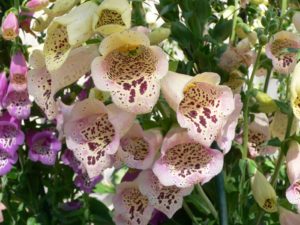
While the Foxglove is gorgeous with its lovely bell blooms, they are poisonous to humans, dogs, and cats. And considering this, one should exercise caution when planting where children play or animals roam.
Even though the Foxglove is poisonous, medicine is made from it to treat heart issues. Digoxin is a chemical found in the foxglove plant. It is a drug that increases the force of heart contraction and also slows the conduction of electrical impulses through the heart. Digoxin is currently licensed to treat heart failure and certain heart rhythm issues. Odd, isn’t it, that a wonderful and powerful medicine made from a plant, which has saved thousands of lives is poisonous? 
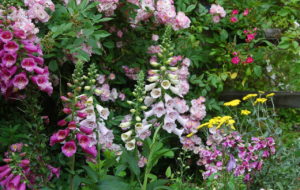
You may or may not believe the stories of fairies and Foxgloves, but I can tell you Foxgloves invite other lovely guests to your garden. Hummingbirds, butterflies, and bumblebees, just to name a few. Your garden will be buzzing with the beauty of brightly colored wings and enchanting flying creatures. If you enjoy photography, this is a golden opportunity to sit quietly and snap photos of your special visitors. From early summer these beautiful flowers will spire upwards creating an unmatched charm in the garden. Often growing in groups, these short-lived plants will add fantastic height and self-seed freely if given the right conditions. In the spring, new plants will often not appear until the ground is warm, so be careful as you go about early weeding.
A spot with a bit of dappled shade is perfect for these flowers and is what they love best. Although, they will do well in a sunny location if provided with regular early morning watering. Foxgloves are biennial, which means that the first year they will not flower but build a nice cushion of leaves. Then in their second year, they will put on their show of color and gorgeous spires, often reaching over four feet in height. Their colors will be in shades of pink, purple, yellow and cream.

In closing, perhaps if you have not grown Foxgloves, you will give them a try. Along with being beautiful, they are deer resistant, something I know is important for many gardeners. And you just never know, fairies may visit your garden!
Thanks so much for your visit, know I love reading and appreciate your comments.
Wishing you a beautiful day and weekend!
Au Revoir,
Sandra
Images: Via Tumblr and Pinterest
Now I know I must plant some! I loved hearing the stories of how they got their name.
They should do very well in your area, Penny. I love how they re-seed themselves and come up here and there.
I do love foxgloves. As they do not overwinter easily, we tend to buy them ready made as annuals and just enjoy for the season.
Your photos are gorgeous, Sandra. Such lovely specimens. And the wonderful bits of poetry to go along with your lovely stories, including the information about this beautiful plant. It all adds up to a magical post. Thank you!!
Brenda xox
Ah, Brenda ~ Thank you for your lovely kind words. Depending on the winter, often Foxgloves will not winter here either. But I have learned to wait until mid-May before weeding where they were planted. As they will often pop up when the ground is finally warm.
Hi Sandra! I do love foxgloves and I so enjoyed reading about them. I have bought them as annuals, but they didn’t do well. I love how you research history and folklore to share with your readers. Have you had success with them?
Hi Pam, so good to see you. It most likely is too warm in your area for Foxgloves. I didn’t have great success with them when we lived in VA. However, they do quite well here in North Central West Virginia. Actually, I have a little cove of seedlings that have sprouted and I will be transplanting them soon. The ones that I had last year didn’t winterover (dreadfully cold winter), but when the ground warmed up came the little ones. They are so pretty and fun – but touchy!
Foxgloves are enchanting. I love the painting of the fox and foxgloves as well as the folklore about fairies and foxes. I have had a love affair with them for years and squeal with delight when we can find them to buy. They are definitely annuals for us and don’t last long. It is April when they bloom here.
I enjoy your quotes so much.
Thanks so much for your visit Bonnie and for your kind words.
I know how you feel about foxgloves they do strike a cord in a gardeners heart. I have enjoyed growing them here, as I longed for them all the years we were in VA. They are not happy with the sandy soil, heat, and humidity of Coastal Virginia.
I absolutely loved this post! I learned so much. I had heard they were poisonous so elected not to plant them in my English garden as y sweet young doxie tends to be a digger/chewer. But perhaps in a large pot would work.
Oh, Laura ~ so happy to see you here and glad you enjoyed the post. We had a Black Lab for almost 13 years and bless her heart, she wanted to put absolutely everything in her mouth. So, I always had to plant them where they were out of her reach. I have never tried them in a pot – but that is how great things are born. So give them a try and see how it works.